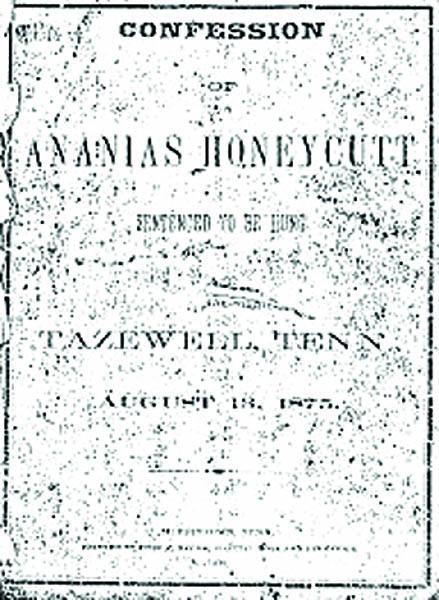The hanging of Ananias Honeycutt
From the Mountains

Tazewell is the county seat of Claiborne County in northeast Tennessee.
The hanging of Honeycutt was witnessed by nearly 6,000 people who came by horse, wagon and on foot from a wide area. Families used the occasion for picnicking and visiting.
An interesting visitor was notorious outlaw Frank James of Missouri who was visiting friends in the area and inconspicuously watched the execution from a second-floor window of the Tazewell College after paying a local resident a $5 gold piece for his vantage point.
The 25-year-old Honeycutt claimed he had argued about a hog with Thomas Ausmus on January 30, 1874. During the dispute in Powell Valley where they both lived, he struck Ausmus three times with a rock. He said his actions were in self defense and after striking Ausmus he left him alive with a man named Greenlee.
Honeycutt was arrested 100 miles away a week after the incident and he was transported back to Tazewell and incarcerated in the city jail. Later he was taken to the murder scene and questioned.
It was reported that Honeycutt admitted he planned to kill Ausmus but several people who were present said they heard no such admission. Others reported that on their way back to the Tazewell jail Honeycutt admitted his plans to kill Ausmus for his money. The two men were neighbors.
In the trial Honeycutt said he admitted nothing more than having a dispute with Ausmus and striking him. He strongly professed his innocence and sought to have the trial moved. His request was denied. Honeycutt’s attorney sought to have his statements set aside because they were made under duress. This too was denied.
The physical evidence were the wounds to the head of the slain man and the bloody rocks found at the scene near the body. Although the ground was wet it did not show signs of a struggle. Honeycutt contended there had been. Tracks of both men were found from the road to the hollow where the fateful event occurred. Honeycutt’s left foot was shorter and had turned up toes. This left a distinct print that was seen approaching and at the murder scene.
Honeycutt’s case was damaged when it was learned Greenlee had not been with the two men on the fateful night and still further by his flight from the area on the night the killing occurred. That is often indicative of guilt. Honeycutt was found guilty as charged. The case was appealed to a higher court and it brought the same result, guilty as charged.
The sentence of the jury was death by hanging. Honeycutt was held in the Tazewell jail that was built in 1816.
On the day of the hanging Honeycutt rode to the gallows sitting atop his coffin on the back of Sheriff Mayes’ open wagon drawn by two horses. They took him to Academy Hollow which is only fifty feet off where Highway 25E is now located. The procession was surrounded by 50 guards who were positioned directly under the noose once they arrived at the hanging site. No one would steal their prisoner or affect the event.
“Lord who can abide in thy tabernacle? Who shall dwell in thy holy house,” Preacher Billy Crutchfield questioned as he read from the Bible, bringing the crowd to a hush.
“He that walks uprightly, works righteously and speaks the truth in his heart.” He said in answering his own question. “Not those that backbites with his tongue or doeth evil to a neighbor or takes up a reproach against his neighbor. He honors those that fear the Lord.”
Reverend Crutchfield read the 15th Psalm and sang a hymn with many in the crowd joining in. Reverend T. P. Ensor followed with a prayer as the prisoner continued knelling quietly beside his coffin.
“And as it is appointed unto men once to die and after this the judgement,” Crutchfield read from the ninth chapter of Hebrews as he followed with a sermon. For nearly an hour his voice boomed for all those present to hear.
Reverend A. J. Greer proceeded with a second sermon as the destined man waited on the wagon beneath the noose. In his conclusion Rev. Greer spoke directly toward Ananias Honeycutt as he read from the fourth chapter of Amos, “Prepare to meet thy God.”
The sheriff asked the prisoner if he had anything to say.
“This is very hard for me,” Ananias said in a soft voice. “It is hard for me to face such a death. I’m sure it is hard for anyone who knows the end has come but I have made peace with God. I am in his hands. Soon I will meet many relatives and friends who have gone on to Heaven before me. I’ll also be waiting for many of you with my Father in Heaven.
“I want to say again that I am innocent of the murder that I have been charged with. I can say that over and over but it has little meaning. It’s as though no one hears. I know I must face death. I don’t want to but I am ready.”
Reverend Greer gave Honeycutt a handkerchief and asked that he shift if from hand to hand in his dying moment if he is innocent. The sheriff placed a black cap over his face and head and stretched the noose around his neck so tight that Honeycutt had to stand on his tiptoes.
The wagon was pulled forward at 2:10 p.m. leaving Honeycutt hanging, suspended, struggling in midair with only the rope around his neck. He kicked and gyrated seeking some relief from the torture. He methodically moved the handkerchief from one hand to the other and back, back and forth, claiming his innocence.
People cried, screamed and some fainted. Sobs and moans echoed through the massive crowd as the hanging man twisted about, switching the handkerchief back and forth, slower then still slower as death neared. In the end when death occurred the handkerchief fell to the ground bringing many moans from the throng of humanity.
It took nearly 15 minutes before Honeycutt died and at 2:36 p.m. his body was taken down and transported to Powell Vallely for burial.
The horrible spectacle led to the discontinuation of public hangings in the state of Tennessee.
Copyright Jadon Gibson 2023. Jadon Gibson is a widely read Appalachian writer from Harrogate. His writings are both historic and nostalgic in nature. Thanks to Lincoln Memorial University, Alice Lloyd College and the Museum of Appalachia for their assistance.


